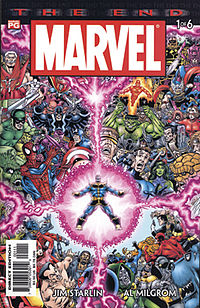- Marvel: The End
-
Marvel: The End [[Image:  |250x450px]]
|250x450px]]
Cover to issue #1Publication information Publisher Marvel Comics Format Limited series Publication date 2003 Number of issues 6 Main character(s) Marvel Universe Creative team Writer(s) Jim Starlin Penciller(s) Jim Starlin Inker(s) Al Milgrom Marvel: The End is a six-issue comic book series published in 2003 by Marvel Comics. It was written and penciled by Jim Starlin and inked by Al Milgrom. Marvel: The End is part of the The End line of comics, and is thus far the only publication in that line to actually occur in the actual Marvel Universe (Earth-616). The series was collected in trade paperback format as Thanos: The End.
Plot summary
The Titan Thanos discovers the existence of a near infinite source of energy, which he calls the Heart of the Universe. The power of this cosmic artifact, also known as the Heart of the Infinite, exceeded that of any other similar artifact, including the Infinity Gems, the Cosmic Cubes, and the cosmic entities - including the all-powerful Living Tribunal. The Heart was discovered millennia ago by a group of alien explorers who learned to harness its great energy and became the Celestial Order. The Order decided to use the power to attempt to forcibly bring peace to the universe, by appointing beings they deemed worthy of the Heart's power to rule sectors of the universe. The Order chose the ancient Egyptian pharaoh Akhenaten as their agent on Earth.
Arriving on modern-day Earth, Akhenaten uses the Heart's power to conquer the Earth, killing most of its superhumans (including the Avengers) in the process. The villain Doctor Doom attempts to kill Akhenaten by traveling back in time and killing him while he was still human, but this is stopped by the all-powerful pharaoh. Akhenaten goes on to kill many of Earth's deities. Thanos gathers the last of the heroes, including the Defenders and Captain Marvel, to seek the Order. As they fought the Order, Thanos destroyed the instruments that allowed them to access the power of the heart. However, the Celestial Order's stored energies were still too great for the heroes. Thanos then jumped into the Heart, believing that his body would be able to directly absorb the power of the Heart, as Thanos had more experience with cosmic power than either Akhenaten or the Order. Upon merging with the Heart, Thanos gained ultimate power, which he used to go back in time and destroy the Celestial Order before they found the Heart of the Universe. Akhenaten is then killed when Thanos prevents him from stopping Doom from killing his past self.
However, contact with the Heart of the Universe allows Thanos to learn that, due to a fundamental flaw, the universe is doomed to end very soon, and that this flaw could not be corrected even by the power of the Heart of the Universe. After a while, the Living Tribunal gathers a group of the most powerful cosmic beings (including Eternity, Infinity, Death, Galactus, and the Celestials) gather to stop Thanos. Despite their virtual omnipotence, the cosmic beings are unsuccessful, since Thanos had, by absorbing the Heart of the Universe, not simply become more powerful - as was the case when he wielded the Infinity Gauntlet - but had actually become one with everyone and everything; even the Living Tribunal had become no more than a "part" of Thanos. However, it is uncertain whether this was the true Living Tribunal or merely a manifestation, as the entity is supposedly beyond the beings and artifacts of any one universe.)
Ultimately, Thanos learns that the only way for him to repair the flaw in the universe would be to destroy the universe and re-construct it. He is finally driven to mindless rage by the attempt of the cosmic powers to usurp his reign, and decides in one fateful, final moment to absorb the entirety of the universe back into himself, so that none might ever again threaten his reign. Thanos is thus able to use the Heart's power to absorb the cosmic beings into himself - and, in doing so, he absorbs the entire universe. The cosmic hero Adam Warlock, who was outside space-time continuum when Thanos absorbed the universe, appeared to Thanos and explained to him what had transpired. Adam convinced Thanos to sacrifice himself to restore the universe. Thanos speculated that the whole scenario had been a set-up from the beginning by a far greater power (implied to be the "God" of the Marvel Universe) to fix the universal flaw. Thus, Thanos had himself been manipulated and possibly even guided. In his last act, Thanos restores the universe but wipes himself from existence, a sacrifice remembered only by Warlock. [1]
Despite his apparent self-destruction, Thanos either survived or was returned to life in the recreated universe. It is uncertain whether or not the Heart of the Universe exists in the recreated universe. Warlock eventually sought out and confronted Thanos over the Titan's actions.[2]
Status in canon
Although originally solicited as an out-of-continuity story, like the other The End comics, Marvel: The End was later confirmed as a part of the Marvel Universe by references to the series in the Thanos ongoing series and, later, in the 2006 editions of the Official Handbook to the Marvel Universe. Marvel editor Tom Brevoort has stated that the series - or, at least, events similar to those depicted in the series - actually did occur in the Marvel Universe.
Footnotes
Categories:- Comic book limited series
- The End titles
Wikimedia Foundation. 2010.
